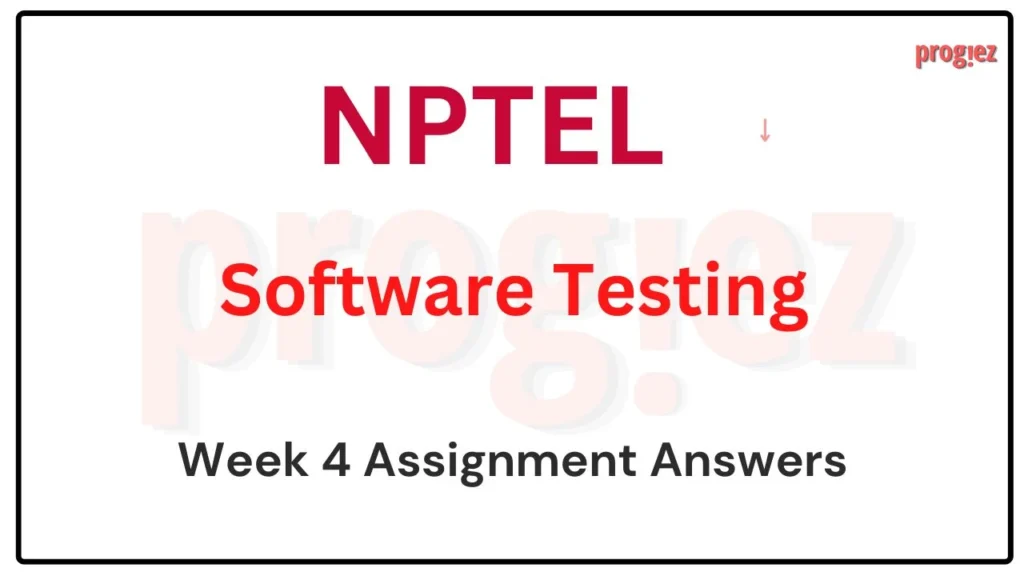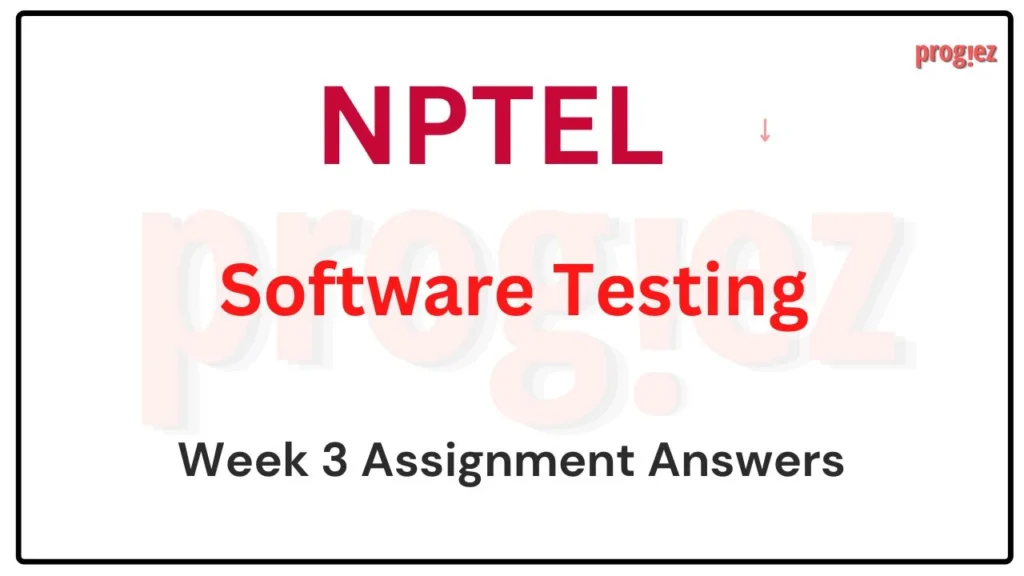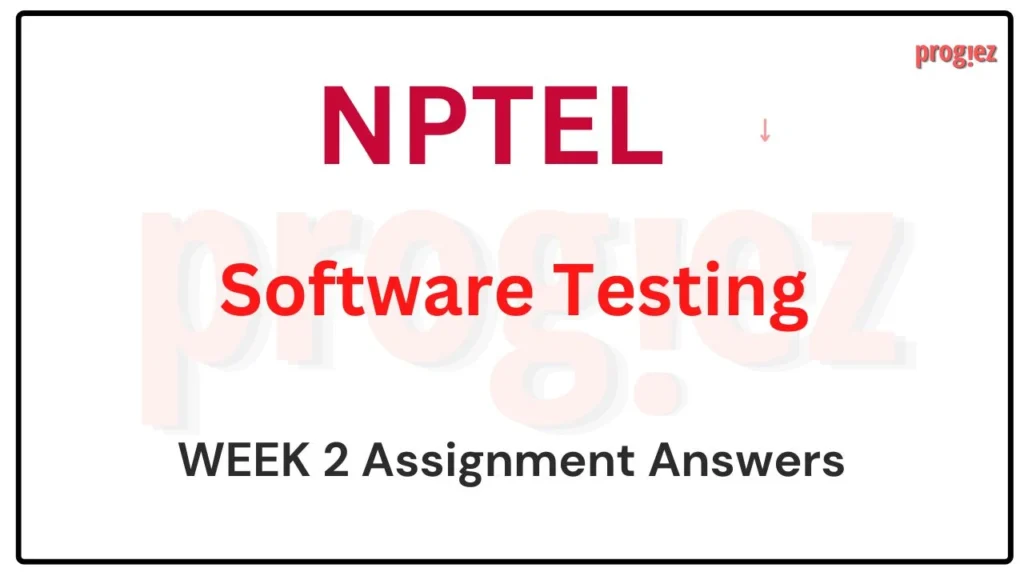Software Testing NPTEL Week 4 Assignment Answers
Are you looking for Software Testing NPTEL Week 4 Assignment Answers? You’ve come to the right place! Access the latest and most accurate solutions for your Week 4 assignment in the Software Testing course. Our detailed answers are designed to help you understand key concepts and excel in your studies. Stay updated with the most recent information and answers by joining our Telegram channel.
Course Link: Click Here
Table of Contents

Software Testing NPTEL Week 4 Assignment Answers (July-Dec 2024)
1. If a particular method A in a class sends a message using an exclusive buffer to a method B in another class, which type of interface does this constitute?
A) Class interface.
B) Buffer interface.
C) Message passing interface.
D) Shared interface.
Answer: C) Message passing interface.
2. In a call graph that represents all the function or method calls, what does edge coverage achieve?
A) Edge coverage tests for executing every call at least once.
B) Edge coverage tests for executing all the paths that contain calls at least once.
C) Edge coverage tests for sending data on call interfaces.
D) Edge coverage tests for calling every function or method in any order.
Answer: A) Edge coverage tests for executing every call at least once.
3. Which of the following best defines a coupling du-path?
A) A coupling du-path is from a coupled definition of a variable to the corresponding use.
B) A coupling du-path is from the last definition of a variable to the first use of the same variable.
C) A coupling du-path is from a definition of a variable to its use such that there is no definition in between.
D) A coupling du-path is from a last definition of a variable to any use across a call interface.
Answer:D) A coupling du-path is from a last definition of a variable to any use across a call interface.
4. State true or false: While testing for data flow in call interfaces, we need not consider only the last definition and the first use of a particular variable.
A) True.
B) False.
Answer: A) True.
5. While testing for sequencing constraints on specifications using graphs, what kind of test paths are typically used?
A) Test paths are defined to satisfy the sequencing constraints.
B) Test paths are defined to violate the sequencing constraints.
C) Test paths are dependent on the kind of sequencing constraints, might satisfy them or violate them.
D) Test paths are the sequencing constraints themselves.
Answer: A) Test paths are defined to satisfy the sequencing constraints.
These are Software Testing NPTEL Week 4 Assignment Answers
6. Consider a finite state machine that models the behaviour of a bounded queue data structure that is used in a piece of code. What do the states of the machine represent?
A) The states of the finite state machine represent the operations supported by the queue data structure.
B) The states of the finite state machine represent the contents of the queue, one state for every cell in the queue.
C) It is not possible to represent a bounded queue data structure using a finite state machine.
D) The states of the finite state machine represent the contents of the queue, one state when the queue is empty, one state when the queue has only one element, and so on, one state when the queue is full.
Answer: D) The states of the finite state machine represent the contents of the queue, one state when the queue is empty, one state when the queue has only one element, and so on, one state when the queue is full.
7. State yes or no: Does the sequence of two consecutive invocations of the write() method violate any of the above sequencing constraints?
A) Yes.
B) No.
Answer: B) No.
8. State yes or no: Does the path that has two consecutive invocations of the read() method violate any of the above sequencing constraints?
A) Yes.
B) No.
Answer: B) No.
9. Identify a path that violates one of the above sequencing constraints from the paths given below.
A) Path: open(), read(), write(), write(), close().
B) Path: open(), suspend(), read(), close().
C) Path: open(), read(), read(), close().
D) Path: open(), read(), read(), write(), close().
Answer: B) Path: open(), suspend(), read(), close().
These are Software Testing NPTEL Week 4 Assignment Answers
10. Does the edge from open() to suspend(), representing the suspension of an open operation, violate any of the sequencing constraints given above?
A) Yes.
B) No.
Answer: B) No.
All Weeks of Software Testing: Click here
For answers to additional Nptel courses, please refer to this link: NPTEL Assignment Answers
Software Testing NPTEL Week 4 Assignment Answers (Jan-Apr 2024)
Course name: Software Testing
Course Link: Click Here
For answers or latest updates join our telegram channel: Click here to join
These are Software Testing NPTEL Week 4 Assignment Answers
Q1. Which of the following statements concerning mutation testing is correct?
a. Mutation testing is used to test if a program has bugs
b. Mutation testing is used to test if it is possible to mutate the program
c. Mutation testing is used to test if the test suite is adequate
d. Mutation testing is used to count the number of mutants of the program
e. Mutation testing is used to test whether the performance of the software is satisfactory
Answer: c. Mutation testing is used to test if the test suite is adequate
Q2. Which of the following mutants are considered as equivalent mutants?
a. Mutants which arise from identical changes made to the program
b. Mutants which arise from similar changes made to the program
c. Mutants which fail with the same set test cases
d. Mutants pass the same set of test cases
e. Mutants which are detected by all the test cases
f. Mutants which cannot be killed by any test case
Answer: f. Mutants which cannot be killed by any test case
Q3. Which of the following are not true of mutation testing technique?
a. Hard to automate mutant generation
b. Mutant generation is computationally expensive
C. Presence of equivalent mutants make it difficult to automate the entire mutation testing process
d. A very large number of mutants can be generated.
e. Mutation testing is very effective for eliminating simple programming errors
Answer: a, b
For answers or latest updates join our telegram channel: Click here to join
These are Software Testing NPTEL Week 4 Assignment Answers
Q4. In the context of mutation testing, suppose in your program you replace the instruction y=2*x by y=x+x, to create a mutant. Which one of the following kinds of mutant would you create?
a. Trivial mutant
b. Transparent mutant
c. Stillborn mutant
d. Equivalent mutant
e. Erroneous mutant
Answer: d. Equivalent mutant
Q5. Which of the following statements about alpha testing are NOT true?
a. Alpha testing is often performed by an independent test team.
b. Alpha test cases usually comprise performance tests only.
c. Alpha test cases consist primarily of white-box test cases
d. Faults found during alpha testing are much more expensive to fix than those found during unit and integration testing.
e. End-users are often asked to perform alpha testing.
Answer: b, e
Q6. Which one of the following can be said about regression testing?
a. Ensures that bug fixes are proper and justified
b. Ensures that bugs are not induced in unchanged areas due to bug fixes
c. Ensures that changed areas of the software have no bugs
d. Ensures that unchanged areas of the software have no bugs
e. Regression test cases remain valid throughout the maintenance phase
Answer: b. Ensures that bugs are not induced in unchanged areas due to bug fixes
For answers or latest updates join our telegram channel: Click here to join
These are Software Testing NPTEL Week 4 Assignment Answers
Q7. Which one of the following is a suitable unit for testing object-oriented programs?
a. Statement
b. Method
c. Class
d. Package
e. Class hierarchy
Answer: c. Class
Q8. In an object-oriented program, even if a base class has been thoroughly tested, why is it necessary to retest the inherited methods?
a. An inherited attribute may be modified in an unanticipated way in the derived class
b. Code of methods can get corrupted during the process of inheritance
c. Encapsulation prevents testing base class code
d. Inherited methods can be polymorphic
e. Inherited class may redefine attributes and methods of the base class
Answer: a. An inherited attribute may be modified in an unanticipated way in the derived class
Q9. Which of the following are implied by the polymorphism feature while testing object-oriented programs?
a. Polymorphism makes testing problematic as difficult to find all bindings that may occur.
b. Polymorphism complicates integration testing as many server classes may need to be integrated before a client class can be tested.
c. Simplifies testing as testing any method binding should take care of all possible method bindings
d. Polymorphism provides flexibility and therefore simplifies testing
e. Polymorphism simplifies integration testing as it can be carried out by any of the polymorphic server classes
Answer: a, b
These are Software Testing NPTEL Week 4 Assignment Answers
Q10. Why are top-down and bottom-up testing are not appropriate integration strategies for object- oriented programs?
a. Object-oriented programs are large
b. Object interactions are usually complex
c. Encapsulation complicates integration testing
d. Inheritance complicates integration testing
e. Polymorphism hinders top-down and bottom-up testing
Answer: b. Object interactions are usually complex
For answers or latest updates join our telegram channel: Click here to join
More Weeks of Software Testing: Click here
More Nptel Courses: https://progiez.com/nptel-assignment-answers
Software Testing NPTEL Week 4 Assignment Answers (Jan-Apr 2023)
Course Name: Soft Skills Development
Course Link: Click Here
Q1. Which one of the following correctly states the purpose of carrying out regression testing after every change made to a software?
a. It ensures the unchanged features continue to work fine.
b. It ensures the changed features continue to work fine.
c. It ensures that the obsolete test cases are removed from the test suite.
d. It ensures that the test suite is properly optimized
e. It ensured that the test suite is properly prioritized
Answer: a. It ensures the unchanged features continue to work fine.
Q2. Which of the following correctly state the purpose of the error seeding technique?
a. Determine the origin of the bugs
b. Plant trojans in code
c. Determine the number of latent bugs
d. Plant insidious bugs before delivery to the customer
e. Introduce known bugs in code to determine whether testing is adequate
Answer: c, e
These are Software Testing NPTEL Week 4 Assignment Answers
Q3. The main purpose of integration testing is to find which one of the following types of errors?
a. Logic errors
b. algorithm errors
c. Arithmetic errors
d. Design errors
e. Module interfacing errors
Answer: e. Module interfacing errors
Q4. Which of the following types of testing are usually not performed during acceptance testing?
a. Stress testing
b. Functionality testing
c. Mutation testing
d. Recovery testing
e. White box testing
Answer: c, e
These are Software Testing NPTEL Week 4 Assignment Answers
Q5. Capture and replay type of tools are useful to carry out which one of the following types of tests?
a. Regression testing
b. Performance testing
c. Mutation testing
d. Smoke testing
e. Monkey testing
Answer: a. Regression testing
Q6. Usability issues are tested during which one of the following type of testing?
a. Unit testing
b. Integration testing
c. Performance testing
d. Regression testing
e. Smoke testing
Answer: c. Performance testing
These are Software Testing NPTEL Week 4 Assignment Answers
Q7. In an object-oriented program even if the base class has been thoroughly tested, why is it necessary to retest the inherited methods?
a. A new context of usage occurs in the derived class
b. Code of methods can get corrupted during the process of inheritance
c. Encapsulation prevents testing base class code
d. Inherited methods can be polymorphic
e. Base class methods get augmented during the process of inheritance
Answer: a. A new context of usage occurs in the derived class
Q8. Which one of the following do not support of automating regression testing?
a. Regression test cases are executed frequently
b. Regression test cases are a subset of the original test cases
c. Effective capture and replay type of testing tools are available as open source as well as from commercial offerings
d. Some of the original test cases may require maintenance after a change
e. Code changes may require some of the test cases to be redesigned
Answer: b, d, e
These are Software Testing NPTEL Week 4 Assignment Answers
Q9. Which of the following is/are usually not included in the test report?
a. Pre-condition for test case execution that were set up
b. Test inputs exercised
c. Number of times a test case was observed to fail
d. Test outputs observed
e. The suspected error that is causing failure of a test case
Answer: c, e
Q10. From the following, pick the odd testing technique out.
a. Compatibility test
b. Usability test
c. Documentation test
d. Security test
e. Unit test
Answer: e. Unit test
These are Software Testing NPTEL Week 4 Assignment Answers
More Weeks of Software Testing: Click Here
Software Testing NPTEL Week 4 Assignment Answers (Jul-Dec 2022)
Course Name: Software Testing
Link to Enroll: Click here
These are Software Testing NPTEL Week 4 Assignment Answers
Q1. Which of the following best describes a test driver?
a. It is a special purpose implementation of a software module, used to develop or test a component that calls it.
b. It is a software component that replaces another component that takes care of the control and/or the calling of a software component.
Answer: b. It is a software component that replaces another component that takes care of the control and/or the calling of a software component.
Q2. If method A uses a variable v shared with method B, where A writes to v and B reads from v, then, it is an example of which kind of coupling interface listed below?
a. Parameter coupling.
b. Interface coupling.
c. External coupling.
d. Shared data coupling.
Answer: d. Shared data coupling.
These are Software Testing NPTEL Week 4 Assignment Answers
Q3. To test sequencing constraints that occur as requirements specification, which of the following tests are used?
a. Tests are inputs to sequencing constraints that violate the constraints.
b. Tests are inputs to sequencing constraints that satisfy the constraints.
c. Tests are sequences of method calls, as they occur in the specification.
d. Tests are randomly generated sequencing constraints.
Answer: a. Tests are inputs to sequencing constraints that violate the constraints.
These are Software Testing NPTEL Week 4 Assignment Answers
Q4. A simple path from the last definition to the first use of a coupling variable is called as . . . . . . . ..
a. A du path.
a. A coupling du-path.
Answer: a. A coupling du-path.
Q5. State Yes or No: Are control flow graphs representing code the same as finite state machines that represent the same code?
a. Yes
b. No
Answer: b. No
Q6. Which of the following is true with reference to the graph satisfying the sequencing constraints?
a. All the sequencing constraints are satisfied.
b. Constraints (1) and (2) are satisfied but (3) and (4) are not.
c. Constraints (1), (2) and (3) are satisfied but (4) is not.
d. All constraints are violated.
Answer: b. Constraints (1) and (2) are satisfied but (3) and (4) are not.
These are Software Testing NPTEL Week 4 Assignment Answers
Q7. State true or false: The path (1,4,5,7) satisfies constraint (4).
a. True.
b. False.
Answer: b. False.
Q8. State true or false: The path (1,2,3,7) satisfies all the constraints.
a. True.
b. False.
Answer: a. True.
Q9. State yes or no: Does the path (1,4,6,7) violate any of the constraints?
a. Yes.
b. No.
Answer: b. No.
These are Software Testing NPTEL Week 4 Assignment Answers
Q10. State true or false: The path (1,4,6,4,6,7) satisfies all the constraints.
a. Yes.
b. No.
Answer: b. No.
These are Software Testing NPTEL Week 4 Assignment Answers





